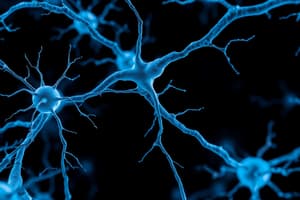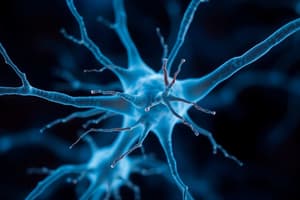Podcast
Questions and Answers
Which part of a neuron is primarily responsible for receiving information?
Which part of a neuron is primarily responsible for receiving information?
- Dendrites (correct)
- Neurites
- Cell body
- Axon
What is the structural composition of the central nervous system (CNS)?
What is the structural composition of the central nervous system (CNS)?
- Brain and spinal cord (correct)
- Spinal nerves and cranial nerves
- Ganglia and nerve fibers
- Cranial nerves and the enteric system
Which type of nerve is entirely sensory?
Which type of nerve is entirely sensory?
- Trochlear nerve
- Olfactory nerve (correct)
- Hypoglossal nerve
- Oculomotor nerve
What distinguishes the peripheral nervous system (PNS) from the central nervous system?
What distinguishes the peripheral nervous system (PNS) from the central nervous system?
Which cranial nerve is responsible for motor control of the sternocleidomastoid and trapezius muscles?
Which cranial nerve is responsible for motor control of the sternocleidomastoid and trapezius muscles?
Which division of the nervous system is responsible for voluntary movements?
Which division of the nervous system is responsible for voluntary movements?
Which of the following statements about mature neurons is correct?
Which of the following statements about mature neurons is correct?
What structural feature differentiates the axon from dendrites?
What structural feature differentiates the axon from dendrites?
Which cranial nerve does not primarily serve the head and neck?
Which cranial nerve does not primarily serve the head and neck?
What are the primary functions of neurons?
What are the primary functions of neurons?
Which characteristic is NOT typically associated with neurons?
Which characteristic is NOT typically associated with neurons?
What term describes the long tubular neurite that conducts impulses away from the cell body?
What term describes the long tubular neurite that conducts impulses away from the cell body?
Which division of the nervous system includes the spinal and cranial nerves?
Which division of the nervous system includes the spinal and cranial nerves?
Which cranial nerves function exclusively in sensory capacities?
Which cranial nerves function exclusively in sensory capacities?
Which of the following is NOT a component of the Peripheral Nervous System?
Which of the following is NOT a component of the Peripheral Nervous System?
Which statement is NOT true regarding the organization of cranial nerves?
Which statement is NOT true regarding the organization of cranial nerves?
Which part of the nervous system is responsible for involuntary control?
Which part of the nervous system is responsible for involuntary control?
How many pairs of cranial nerves are classified as entirely motor?
How many pairs of cranial nerves are classified as entirely motor?
Which structure facilitates communication between the brain and the body's organs?
Which structure facilitates communication between the brain and the body's organs?
Neurons are primarily found in which three locations?
Neurons are primarily found in which three locations?
Flashcards
What is a neuron?
What is a neuron?
A nerve cell and its processes.
What makes a neuron special?
What makes a neuron special?
Neurons are specialized cells that receive stimuli and transmit nerve impulses.
Do all neurons look the same?
Do all neurons look the same?
Neurons vary in size and shape depending on their function.
What's the cell body of a neuron?
What's the cell body of a neuron?
Signup and view all the flashcards
What are dendrites?
What are dendrites?
Signup and view all the flashcards
What's an axon?
What's an axon?
Signup and view all the flashcards
What are nerve fibers?
What are nerve fibers?
Signup and view all the flashcards
What is the CNS?
What is the CNS?
Signup and view all the flashcards
What is the PNS?
What is the PNS?
Signup and view all the flashcards
What are the functional divisions of the nervous system?
What are the functional divisions of the nervous system?
Signup and view all the flashcards
What are cranial nerves?
What are cranial nerves?
Signup and view all the flashcards
Study Notes
Nervous System Overview
- A neuron is a nerve cell and all its processes
- Neurons are excitable cells specialized for receiving stimuli and conducting nerve impulses
- Neurons vary in size and shape, but each has a cell body with branching neurites
- The neurites responsible for receiving information and conducting it towards the cell body are called dendrites
- The single long tubular neurite that transmits impulses away from the cell body is called the axon
- Dendrites and axons are often referred to as nerve fibers
- Neurons are found in the brain, spinal cord, and ganglia
- Unlike most other body cells, mature neurons do not divide or replicate
- The nervous system can be separated into parts based on structure and function
- Structurally, it's divided into the central nervous system (CNS) and the peripheral nervous system (PNS)
- The CNS is composed of the brain and spinal cord
- The PNS is composed of all nervous structures outside the CNS that connect it to the body
- The PNS consists of spinal and cranial nerves, visceral nerves and plexuses, and the enteric system
- Cranial nerves—12 pairs
- Spinal nerves—31 pairs
- The 12 cranial nerves exit the brain through foramina and fissures in the skull
- All nerves are distributed in the head and neck, except cranial nerve X, which also supplies structures in the thorax and abdomen
- Cranial nerves are named as follows: olfactory, optic, oculomotor, trochlear, trigeminal, abducens, facial, vestibulocochlear, glossopharyngeal, vagus, accessory, and hypoglossal
- Olfactory, optic, and vestibulocochlear nerves are entirely sensory
- Oculomotor, trochlear, abducens, accessory, and hypoglossal nerves are entirely motor
- Trigeminal, facial, glossopharyngeal, and vagus nerves are both sensory and motor
- Spinal nerves exit the vertebral column through intervertebral foramina
- 8 cervical, 12 thoracic, 5 lumbar, 5 sacral, 1 coccygeal
- Each spinal nerve is connected to the spinal cord by two roots: the anterior root and the posterior root
- The anterior root consists of efferent (motor) fibers, carrying nerve impulses away from the CNS
- The posterior root consists of afferent (sensory) fibers, carrying nerve impulses to the CNS
Studying That Suits You
Use AI to generate personalized quizzes and flashcards to suit your learning preferences.



